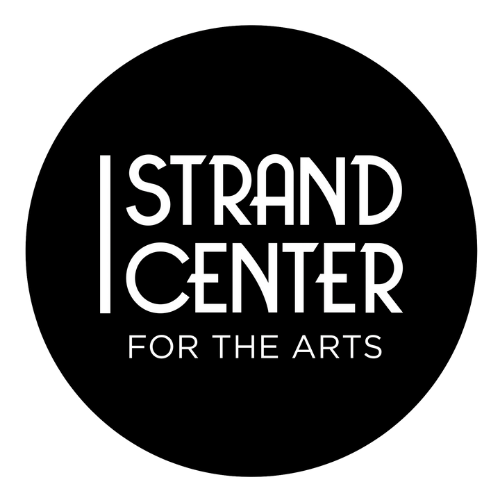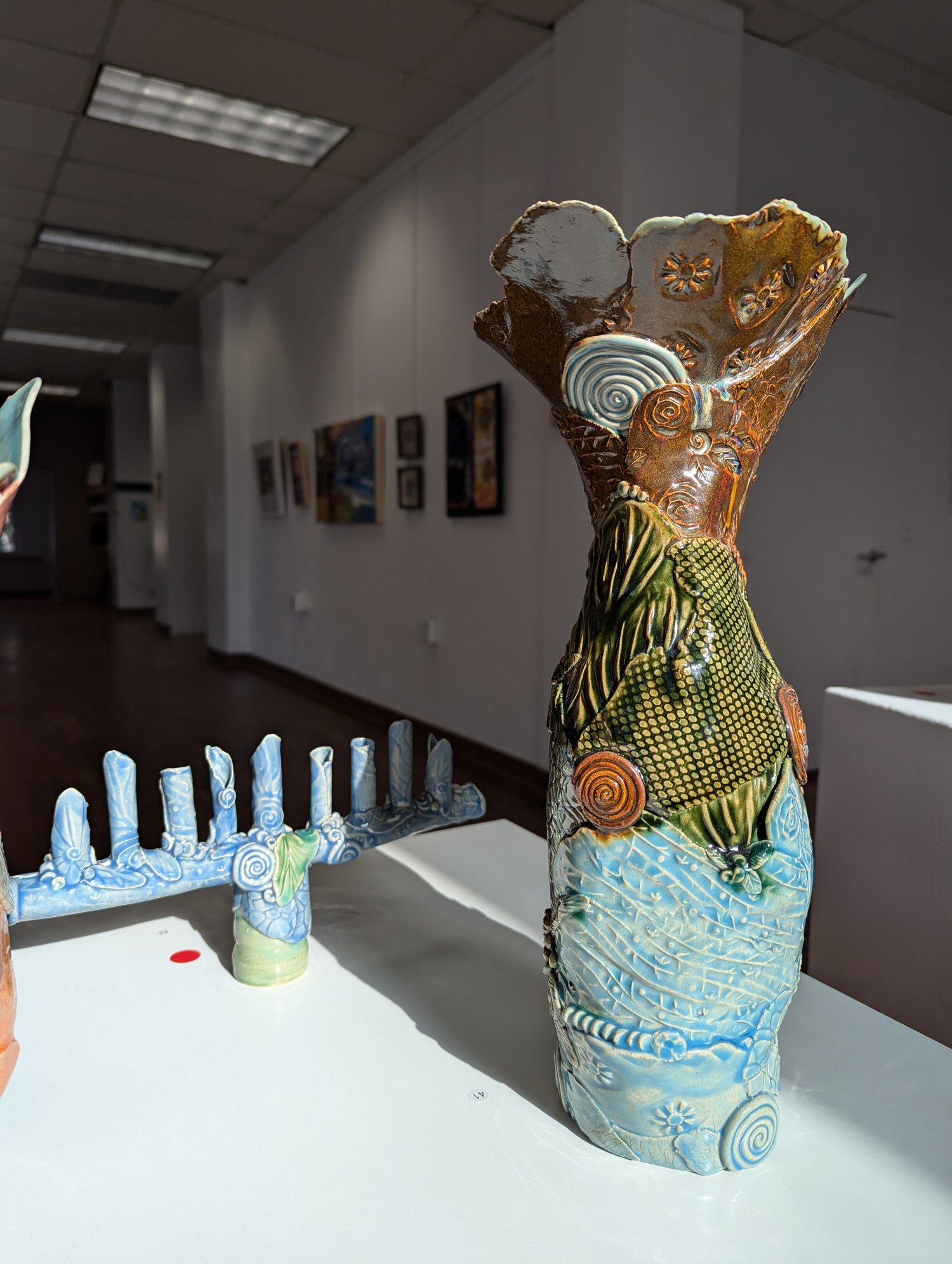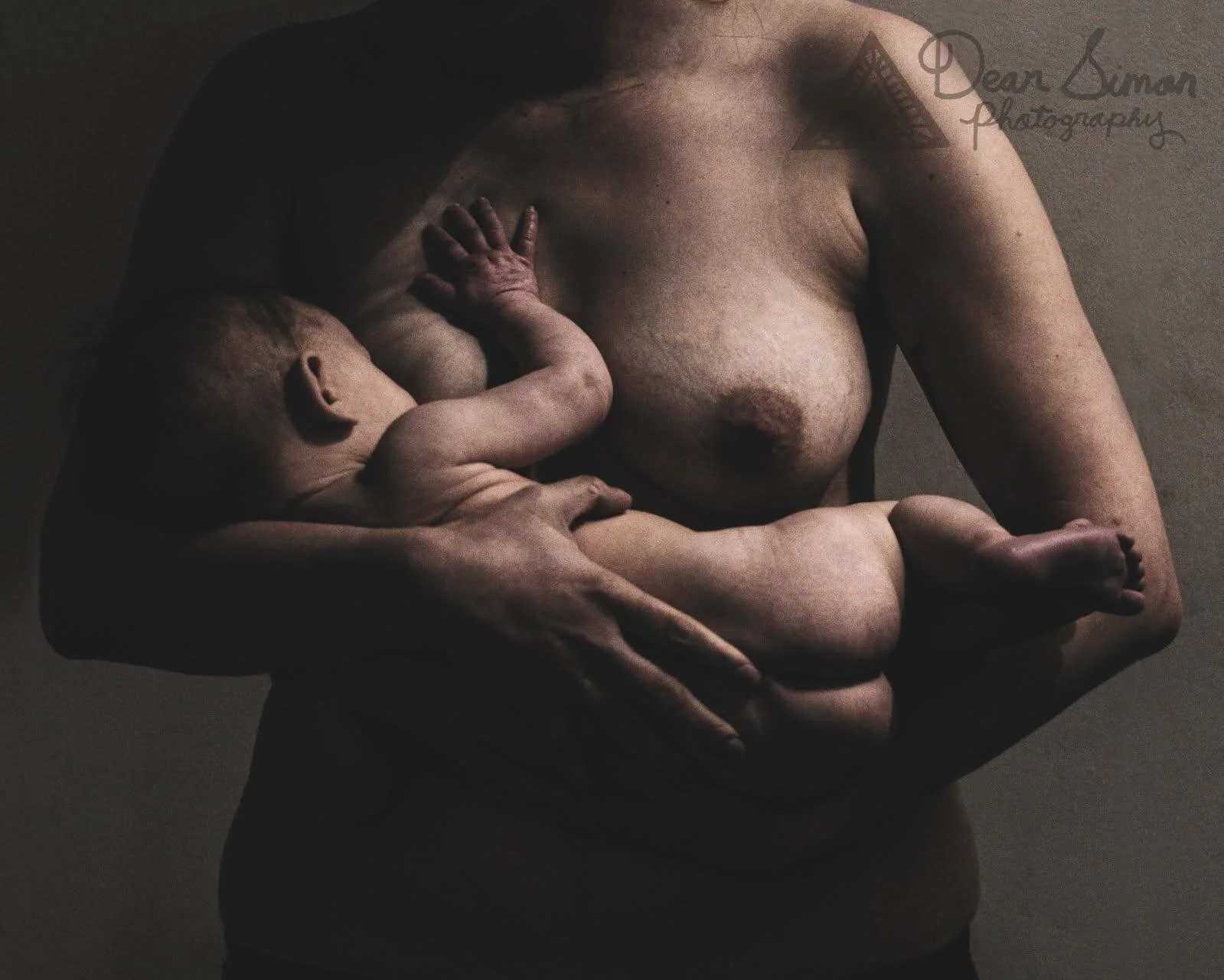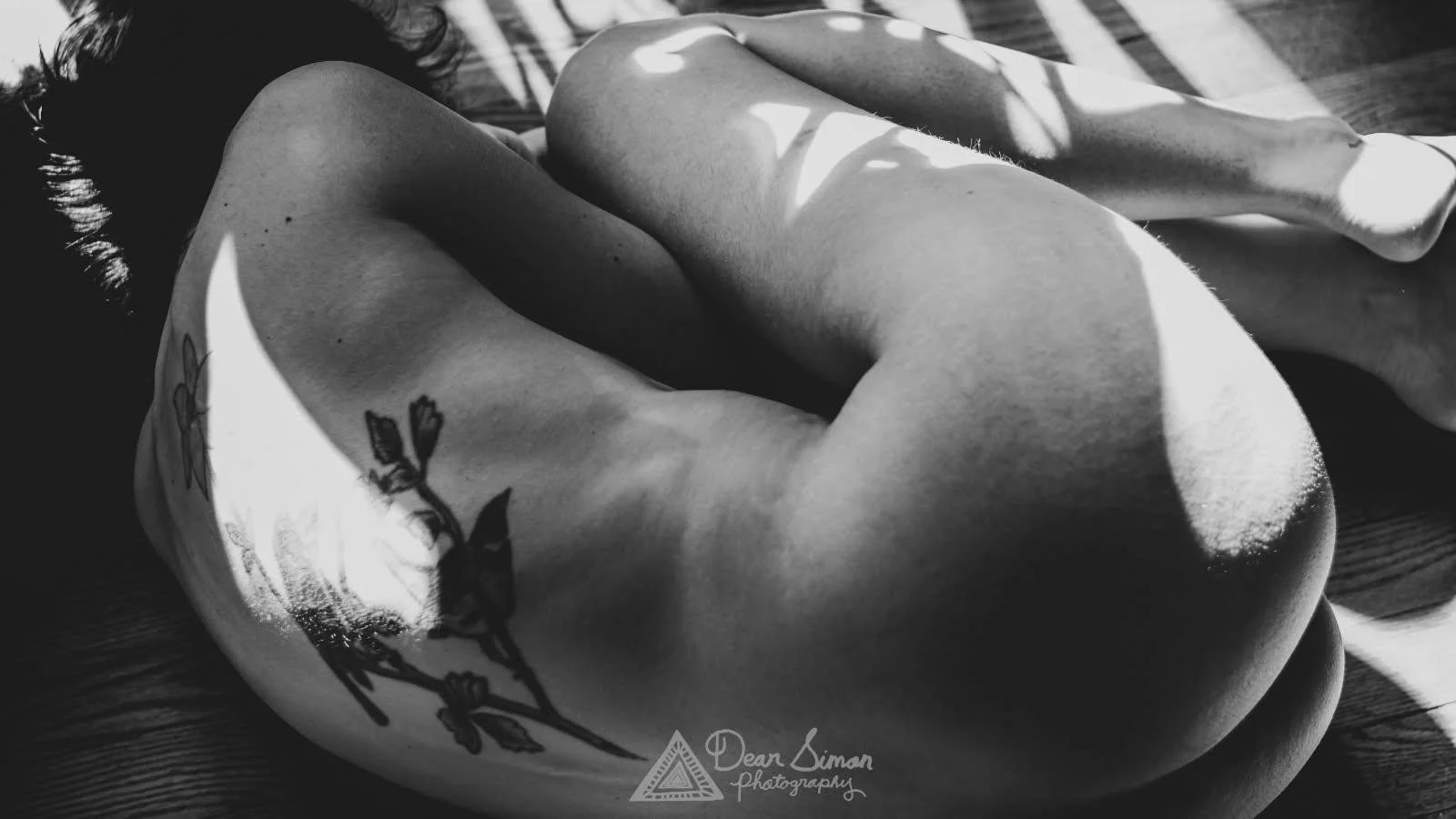The World is Her Canvas: Celebrating Women, Confronting Boundaries
The World is Her Canvas is a celebration of women artists, curated by the Strand Center for the Arts’ Gallery and Event Manager, Elsa Koop-Angelicola, to honor their brilliance while challenging the gender imbalances that persist in the art world. This exhibition brings together a diverse range of works; sculptures, paintings, fiber arts, and photography that offer deeply personal reflections on identity and experience. Through these pieces, Elsa invites viewers to explore the strength, vulnerability, and resilience of women artists, while confronting the traditional narratives that have long sidelined their voices.
In curating The World is Her Canvas, Elsa found herself trying to emphasise celebration and confrontation; honoring the breadth and brilliance of women artists. Through this thoughtfully curatation, the exhibition brings together a compelling mix of sculptures, paintings, fiber arts, and photography, each piece offering a deeply personal glimpse into the artist’s identity and experience. The result is an immersive, emotionally charged collection that invites viewers to reflect on what it means to be both a woman and an artist. The power of this exhibition lies not only in its diversity of mediums and styles but in its ability to articulate the unseen and the often unspoken stories saturated with lore, vulnerability, strength, and creative resilience.
More than just a showcase, this exhibition actively pushes back against traditional narratives that have historically sidelined women's voices in art. By featuring artists of varying ages, backgrounds, and experience levels, it asserts that artistic merit transcends conventional metrics and institutional gatekeeping. Elsa’s intention is that audiences leave with not only an appreciation for the art but also a newfound awareness of the complexities and richness of women’s perspectives. Despite geographic and logistical challenges in assembling the final roster, the passion and precision with which the show was brought together are palpable.
I was honored with interviewing 6 of the 8 artists who bring something distinct yet resonant to the exhibition, collectively affirming that the world, indeed, is her canvas.
For Valerie Hird, the journey of creation has always been rooted in movement, both literal and conceptual. Early in Hird’s career, she refused to let gender define her, even going so far as to reject any label that could confine her. As a young artist she was limited to tools that could fit in the space of her backpack. Relying on pencils, paper and watercolors, she captured fleeting moments and rich cultural exchanges during her travels through the Middle East, North Africa, and Central Asia. Hird found that she often traveled with the privileges of a man, but was enamored with the stories told by women; in her eyes the preservation and storytelling was best done by these women. These voices, full of nuance, humor, and resilience, became the lifeblood of her work, and continue to shape her evolving practice across film, sculpture, and performance today. Though the materials at hand now have grown more lavish and her technique has expanded, she continues to collaborate with women and acknowledge their status as excellent storytellers.
From 2007-2011 Hird’s Maiden Voyages, a bold cross-cultural collaboration born in a digital era before Instagram, revealing the power of shared female experience in conflict zones. By animating and posting the daily realities of five anonymous women from the Middle East, she opened a window into personal truths often lost in mainstream narratives. The project did more than break artistic boundaries; it questioned the very nature of interpretation across cultures, teaching her that while a picture may speak a thousand words, those words vary with each viewer.
Though her practice is deeply personal, it is never isolated. She follows her own curiosity, trusting that others may be drawn to the same questions. Influenced by visionaries like Shahzia Sikander, Aleya Kassam, Firelei Báez, and Janet McKenzie Spens, her work exists in conversation with a global network of women creators who fuse vibrant pattern, language, and layered symbolism. These artists, like her, blur the lines between visual art and storytelling, humor and critique. They remind us that to be a woman in art is not to exist within a single tradition, but to draw from many; to weave stories that are as varied, borderless, and profound as the women who tell them.
For Alise Babbie, empowerment isn’t just a theme, it's the foundation upon which her entire creative practice lingers. Babbie expresses her awareness of the privilege of being a part of a community filled with strong women and mindful men who elevate her voice. She approaches her art with a bold sense of freedom. Within this environment it manifests in works that are delightfully unorthodox, playful, and profoundly personal. By embracing the abnormal, Babbie strives to resist conformity, producing pieces that disrupt expectations and carve space for reinterpretation. Her art doesn’t fit neatly into predefined boxes, especially those imposed on women, and she revels in that ambiguity. Each brushstroke and sculptural form becomes an assertion of autonomy, a refusal to shrink to fit societal molds.
Babbie’s practice is a deliberate push against the boundaries of what is traditionally accepted, whether in medium, message, or aesthetic. In works like Mon, Ma, Mes, she reimagines portraiture as something more kinetic and emotionally charged, using a vibrant palette and daring gestures to animate identity. These portraits don’t just represent a person; they challenge the viewer to see beyond the surface, to confront their own assumptions about art, gender, and expression. Her portfolio becomes an evolving dialogue, one that encourages viewers to rewrite the rules of engagement with contemporary art. Rather than dictating meaning, she offers an open-ended invitation—her art a mirror through which others may glimpse aspects of themselves.
As Babbie is deeply self-aware and unafraid to lean into her own creative instincts, she acknowledges the personal nature of her work with unapologetic clarity. Her process is both introspective and generous, a balance that allows her to explore even the most obscure or “aberrant” ideas with authenticity. Influenced by artists like Brie Ruais and Svitlana Andriichenko, whose works exude texture and gestural power, she finds new freedom in abstraction and material exploration. Looking forward, she envisions her practice expanding in scale and complexity, forever evolving as she continues to challenge both artistic and personal boundaries. Her art doesn’t simply ask to be viewed—it demands to be felt, reconsidered, and remembered.
For Michelle Vara the journey of breaking boundaries began early, with a determination to challenge both societal expectations and the limits of her own creativity. In the birth of her welding practice, it was very apparent that Vara was in a very male-dominate environment. As her work was evaluated, she noticed it was being judged both in technique and aesthetic. This dual scrutiny led her to rigorously educate herself in both the art and the physics of sculpture. However, as a woman, Vara found that with painting, her art was more acceptable than welding and junk collecting.
Vara’s work is a testament to the power of breaking conventions, both artistically and personally. From a young age, she rebelled against traditional expectations, bypassing the constraints of her circumstances to carve out a unique path. Vara graduated high school early as someone who is differently-abled and found herself running away from home to join the circus, fueled by a desire to learn and perform in extreme environments; she found freedom in the pressure of performance. This experience became a cornerstone in her practice: the belief that as long as she could create under duress, there were no limits to what she could produce. The intense, larger-than-life characters she encountered in the circus gave her insight into the dramatic and emotional potential of art, which she continues to explore today. Whether through painting, sculpture, or commissioned works, her art invites viewers to confront and feel deeply, shattering preconceived notions of what art can or should be.
While gender wasn’t a defining factor in Vara’s upbringing, there is thanks to share for the strong, progressive women who shaped her world. Vara found herself drawn to artists who had an equally bold approach to breaking boundaries. The works of artists like David Smith and Picasso left a lasting imprint on her creative psyche. Her father’s unwavering support and exposure to a wide range of art, culture, and thought helped her forge her own path. Today, she navigates the tension between creating art for herself and for public consumption with ease, recognizing the different yet complementary nature of each. Whether it’s the spontaneous creativity that comes from working for herself or the careful consideration required for commissions, she approaches both with the same dedication and clarity of vision. As she looks to the future, she is excited about the possibility of new large-scale commissions and the prospect of working with a gallery that shares her passion for art. Ultimately, her aim is simple yet profound: to continue expanding as both an artist and a human, sharing work that inspires conversation and sparks new ways of thinking.
When it comes to artist Zoe Bedell, intuition, not ideology, guides her hands. Bedell grows her work from a quiet devotion to form, material, and emotion. There’s an unmistakable softness to her approach, shaped by an internal pull toward organic lines and imperfect edges. Bedell’s gravitation to clay lies in the material’s ability to blur the lines of precision with the softness of natural shapes.
Bedell’s practice unfolded not through structured study but through moments of unplanned exploration. A clay class she once found uninspiring became the unlikely turning point, it became a space where “doodling” turned into discovery. Out of that freedom, her current collection of works were born. This instinctive detour away from traditional technique revealed something more profound: the value of play as a creative compass. She’s candid about the inner friction that exists between personal expression and public visibility, describing a persistent self-doubt that questions whether her work will resonate. Still, she pushes forward, fueled by the simple joy of making and the hope that someone, somewhere, might see themselves reflected in the forms she creates.
Bedell’s influences are less about art history and more about proximity—women who live boldly and create without hesitation. Friends like: Michelle Roberts who works in fiber arts and jewelry, Linda Young, a harpist and singer, Amy Kolb Noyes, a author and illustrator, serve as both creative inspiration and emotional scaffolding. These women don't wait for permission; they make, they share, and they trust their voices. Their confidence becomes a mirror for her own aspirations. Looking ahead, she dreams of scaling both up and down—working with intimacy and ambition in equal measure. Whether functional or purely expressive, her pieces are open invitations: to explore, to feel, and maybe even to begin.
In KT Falzetta’s (Dear Simon Photography) practice, the act of creating is deeply intertwined with the experience of being a woman. Female energy, in its myriad forms, flows through every image Falzetta makes, whether or not the piece explicitly depicts a woman. To her, womanhood is not just a subject but an essence that is reflected in nature, growth, and reproduction. Falzetta recognizes it as the fundamental forces that pulse through life itself. Her art is a celebration of this energy, capturing its strength, beauty, and cyclical nature. Even when the subject is absent, the spirit of womanhood remains embedded in every curve and texture, exuding a quiet, undeniable presence.
While her work certainly challenges expectations, it does not necessarily aim to break new ground in terms of gender expression. Instead, it confronts the viewer with a clear, unambiguous representation of women. Falzetta’s art is literal, leaving no room for interpretation in how womanhood is portrayed. Each piece demands that the viewer think of women, to consider their power, their complexity, and their inherent connection to the world around them. This straightforward approach to gender in her work reflects her belief in the importance of visibility, especially in a world where such representations can often be overlooked or diluted.
Her journey as an artist has been shaped by moments of doubt and triumph, none more pivotal than when a local coffee shop decided to display her photography. In that moment, she realized that following her artistic instincts, despite her concerns about commercial appeal, was the right path. What followed was a remarkable shift: over 25 pieces sold, a personal milestone she still finds hard to believe. Her photography business now exists in two distinct realms: the fine art side, where she eschews the "rules" of photography in favor of what feels beautiful and inspiring, and the portrait side, where she follows the more traditional methods. One of the first women to make the biggest impact to Falzetta’s art was Anne Frank. In times when Falzetta feels like there is no inspiration to draw upon she thinks of those who have plenty, yet are without the privilege to act upon it. For the future of Falzetta’s art, she hopes to find her work in more homes, making it accessible for everyone, as the more people who experience her art the more expansive it feels to her.
Eve Petrashune’s art is deeply rooted in her personal experiences as a woman, with themes of birth, death, and the cycles of life emerging as key components of her work. Her piece Symbiosis is a powerful embodiment of these ideas, blending natural elements with a profound reflection on the duality of life and death. Through the juxtaposition of an embroidered figure surrounded by real, deceased insects and leaves, Petrashune invites viewers to explore these transitions as interconnected, rather than opposing forces. While she hasn’t had children herself, her art reflects her contemplation on the ways women provide care, wisdom, and power to the world, often unseen and unacknowledged. This theme of feminine strength and quiet influence pervades her art, positioning women as the unseen architects of society’s structures.
While Petrashune’s art doesn’t explicitly push the boundaries of societal norms in a way some may expect, she sees art itself as inherently rebellious. Society has often struggled to embrace the full spectrum of feminine expression, and her own works navigate this space by challenging the traditional expectations of what art created by a woman should look like. Her interests, which blend traditionally “masculine” hobbies like woodworking with a softer, more emotionally introspective artistic style. Rather than focusing on explicit gender boundaries, Petrashune’s art resonates with a more universal message: that human experience transcends gendered expectations. Through her work, she speaks to a broad audience, revealing that, regardless of gender, we all share the same feelings of longing, loss, and connection.
Petrashune’s journey as an artist has also been one of personal growth, particularly in how she connects her work to her roots. After a period of artistic frustration, she found herself drawn back to the natural world, a theme that has always been close to her heart. Growing up in Saranac, NY, surrounded by forests, fields, and graveyards, her connection to nature remains central to her creative process. Over the years, she has incorporated natural materials into her art, creating a visual language that speaks to her upbringing and personal sense of home. This process of rediscovery has opened new doors for her, allowing her to break away from traditional artistic boundaries and explore new techniques, such as working with film and experimenting with botanical elements. Finding inspiration from the simplistic, yet striking works from Ana Mendieta, she finds a familiar energy that is embodied in Petrashune’s own work. She also finds herself drawn to and impacted by fellow artist KT Falzetta, the poignant photographs leaving a similar feeling as Mendieta’s work with her. As she looks to the future, Petrashune is eager to continue evolving. She finds herself particularly excited about the possible work she could create with her newfound 33mm underwater camera. She is exploring the comfort of integrating more natural materials and techniques into her work, and exploring the endless possibilities that lie ahead.
By pushing back against conventional norms, this exhibition amplifies the often overlooked stories of strength and resilience that women bring to the creative world. Ultimately, it reminds us that the canvas is a space where women’s voices are powerful, necessary, and deserving of celebration. The World is Her Canvas will be on display at the Strand Center Gallery until June 21st, 2025.

























